Are you planning a trip to Africa and wondering what you actually need to pack for a safari? Perhaps you want to travel through Botswana with a 4×4 and roof tent, with the whole family through Kruger National Park in South Africa, go on a game drive in Addo Elephant Park, or take a road trip through Namibia?
Whether it’s a game drive, a bush walk, or a camping trip, there are a few essential gadgets you absolutely shouldn’t forget. In the following article, we’ll tell you what we always have with us on our Africa trips and what you can safely do without. Enjoy browsing through our Safari packing list for Africa.
- Suitcase or backpack?
- What clothing is suitable for safaris?
- What should not be missing from my toiletry bag?
- Which first-aid kit for safaris do you recommend?
- How do I best protect myself from mosquitoes in Africa?
- Safari packing list – Can I do laundry while on the go?
- Which binoculars do you recommend for a safari?
- Which lens do you use for photography on a safari?
- What other technical equipment do you have with you?
- What else should not be missing from your luggage?
- Conclusion to the packing list
Suitcase or backpack?
While we used to travel the world mainly with two backpacks*, things are a little different today. I (Bolle) now have a cool travel bag on wheels* from Decathlon, which offers plenty of storage space. Marco usually manages to fit everything into his small carry-on suitcase*, even for a 3-month trip to Africa. How does he do it? Our packing cubes* have been indispensable for many years. They help you organize things and save a bit of space.
Actually, it doesn’t matter whether you pack your things in a suitcase, a backpack, or a travel bag. In the end, though, I was very glad that I had a travel bag with me that you could compress a bit. This made our luggage fit much better in the trunk. Large suitcases are always quite bulky. Don’t forget a daypack* for hiking, game drives, or walks.
What clothing is suitable for safaris?
1. The right colors
Are you planning a safari and wondering what clothes to pack? You don’t have to rush out and get a typical safari outfit right away. Colors that are also found in the wild, such as brown, beige, khaki, gray, or green, are advantageous. The colors of your safari clothing should therefore be muted and neutral, rather than bright and colorful. Our guide in Namibia told us that he prefers understated colors and that you should avoid colors like red, yellow, blue, pink, purple, orange, or black.
If you’re driving through Kruger National Park in your rental car, it doesn’t matter in the end what color your clothes are. However, if you’re going on a bush walk, you should leave these items in your suitcase and opt for a more understated look. You should be aware that many animals in the wild use striking colors to camouflage themselves or protect themselves. They primarily use bright colors to ward off enemies.

During our trip through Botswana, we heard the craziest stories. Two boys got a flat tire in the middle of the wilderness in the Okavango Delta and, of course, had to get out of the car to change the tire. Elephants and other wild animals were not far away. You don’t want to make these animals nervous or attract their attention with bright colors. And you certainly don’t want to completely ruin your nice white pants while changing a tire, do you?
2. Long clothes or shorts?
Depending on the region and destination, it can be very fresh and cold in the morning, which is why long-sleeved shirts are obviously a plus. Even on game drives, it can get really icy in the open jeep in the morning hours, so a jacket isn’t a bad idea.
In South Africa (e.g., in the Drakensberg Mountains), we mostly wore long trousers, a sweater (or fleece jacket), and a windbreaker, especially in the morning. In Botswana, it was already very warm in the morning, which is why we rarely needed a sweater. Detachable trousers are also useful here (they’re not really our style), so you can quickly adapt to the weather and temperatures.
Since you’ll probably be sitting in a car or jeep for long periods during your game drives, you should pack comfortable and durable trousers. Nothing’s worse than tight, pinching pants during an 8-hour drive! We both always bring our comfortable stretchy chino pants in beige, gray, and khaki.
And, of course, don’t forget shorts for those hot days. In Botswana, however, we mostly wore long (airy) clothing due to the sun and mosquitoes.
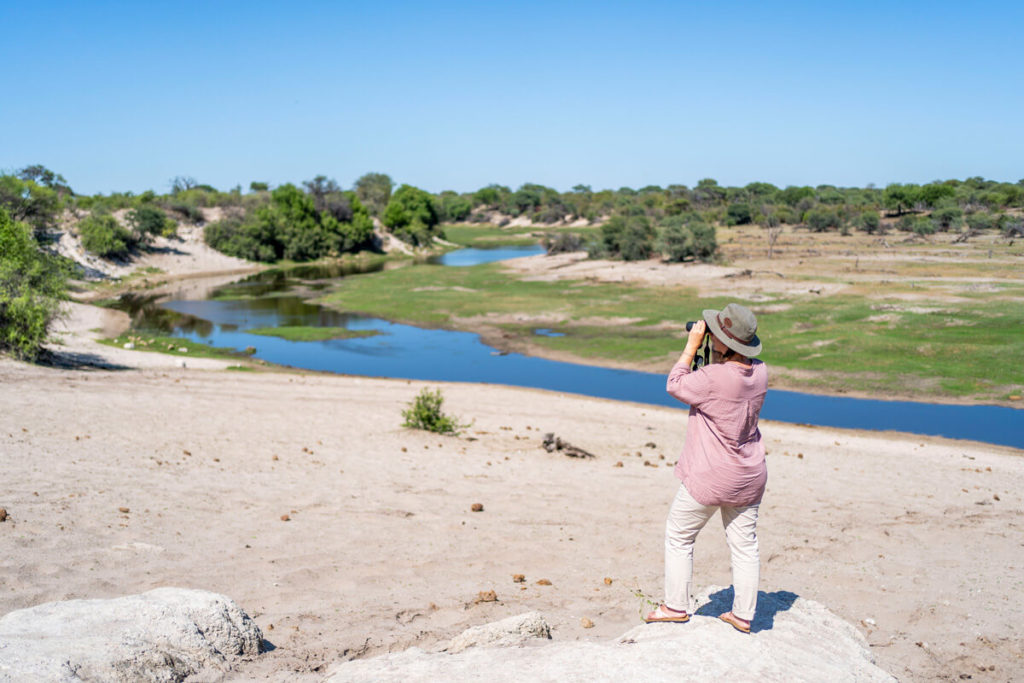
Safari clothing is also inexpensive!
For bush walks (or horseback riding safaris), you should definitely remember to wear long trousers, as you may be walking (or riding) through tall grass or bushes. You certainly don’t want to scratch your legs or attract ticks, right?
On top, I prefer 3/4-sleeve shirts made of muslin or linen, while Marco prefers long-sleeved functional shirts and tops that he can roll up when needed. All my shirts have a small tab on the sleeves so I can roll them up (bought cheaply at a no-name store in Rostock, by the way).
You don’t necessarily have to spend hundreds of euros on designer functional clothing. Honestly, you can overdo it! We usually buy our clothes cheaply at Decathlon, occasionally at a specialty store, or even next door at Globetrotter and Peek & Cloppenburg.
We also only buy clothes that we can wear every day. Since we generally dress more casually, this is always quite straightforward in our case.
3. What shoes should I take on a safari?
We usually wear our comfortable and sturdy trekking and hiking boots on safari trips. Especially on a hike, you don’t want to twist your ankle, feel sharp stones on your soles, or get bitten by small insects. If we’re just sitting in the car during the day, we also like to wear flip-flops or comfortable sneakers.
Ultimately, it always depends on what type of trip you’re going on. If you’re doing one or two game drives in South Africa and are only sitting in the car anyway, you don’t need hiking boots. However, if you are planning a bush walk, a horseback safari, or a trip through the desert, be sure to pack sturdy shoes.
- Bolles flat hiking boots* (always with you)
- Bolles high-top hiking boots* (only for long hikes in the mountains or in winter)
- Marcos trail shoes with a sturdy sole (always with you)
- Marcos high-top hiking boots* (only for long hikes in the mountains or in winter)
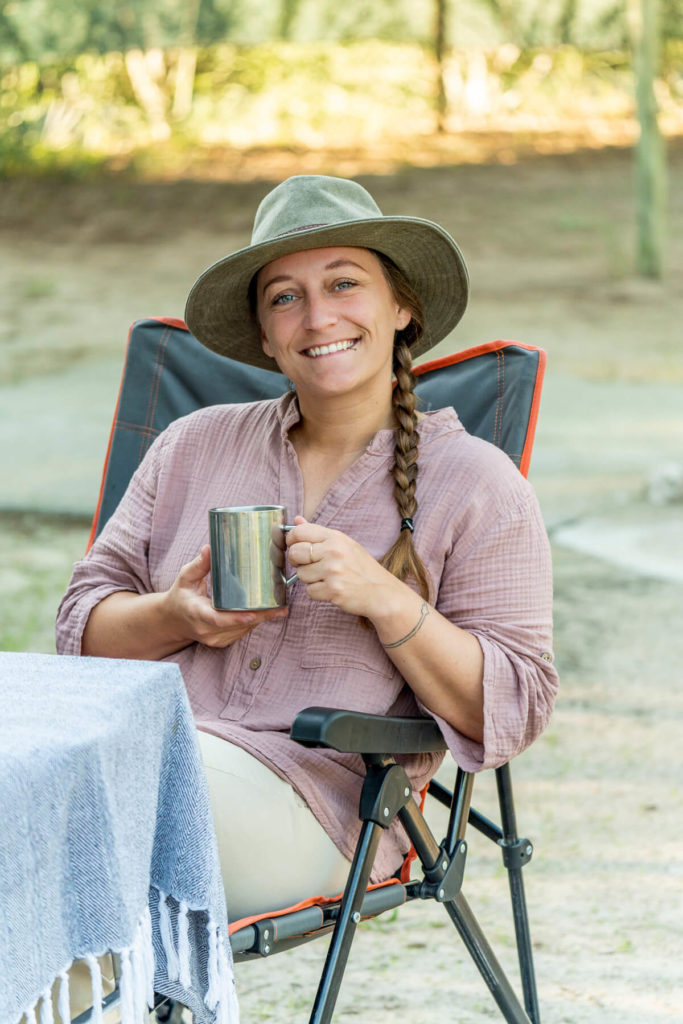
4. Is headwear recommended?
Absolutely! Headwear is generally recommended in very warm countries. We’ve already traveled to very hot regions (Kalahari, Sahara, Israel, Abu Dhabi, etc.) and were always glad to have a cap or hat on our heads. These not only protect against the blazing sun but also against painful sunburn. Besides, you usually don’t know whether an off-road vehicle, safari vehicle, or boat has a roof. Of course, you should also think about protecting your eyes and pack sunglasses.
- Bolles Cap: Black lightweight peaked cap*
- Bolles Hat: Safari Hat* (similar to mine)
- Marcos Sunglasses: MH 530 Sunglasses* (polarized)
5. Clothing for in-between wear
If you’re not on a bush walk or safari, you can of course wear whatever you want in your tent, camp, or lodge. We always bring comfortable clothes (shirts, leggings, sandals) and, depending on your destination, something a bit more dressy for the evening. By that, we mean just regular T-shirts, maybe jeans, a skirt, or a dress. Mostly, though, we dress simply and casually.
During our trip through Botswana, we wore long-sleeved pajamas at night to protect ourselves from mosquitoes. In accommodations with good mosquito nets, you don’t necessarily need to wear long clothing at night. We always carry flip-flops, clogs, or sandals with us so we don’t spend the whole day walking around in hiking boots (also important when camping for showers, hours by the pool, or short walks).
Generally speaking, these days we travel very light (about 10 kg each) and only pack a few outfits and items of clothing that we can easily combine. Even if we’re on the road for 3 months, we only bring enough clothes for about 5 to 7 days. We’ve always been able to do laundry somehow, no matter which country in the world we’ve been to. Less is more when traveling!
6. Should I waterproof my safari clothes?
We waterproofed our clothes before our 3-month trip through Africa. Since we were traveling in the humid Okavango Delta, among other places, we wanted to leave nothing to chance and wanted to protect ourselves as best we could against mosquitoes. We always use Nobite* spray, which you can buy online or from Globetrotter, for example.
The stuff is very expensive, but it does what it’s supposed to. We waterproofed our clothes before the trip and once during the trip, after washing everything. The effect lasts up to 2 to 4 weeks if you don’t wash the clothes. Nobite with DEET is generally recommended for areas where there is a risk of malaria and yellow fever.
Around 50% of all bites penetrate trousers and shirts, which is why waterproofing your safari clothing definitely makes sense. According to the manufacturer, one bottle is enough for 9 items (e.g., a shirt or trousers). This gave us excellent protection from mosquitoes and on our last big trip (3 weeks in Botswana and 9 weeks in South Africa) we didn’t even get 5 bites. After all, prevention is better than cure!
What shouldn’t be missing from my toiletry bag?
We have the cool Tatonka* hanging toiletry bag, which holds an incredible amount of stuff. These hanging bags are particularly useful on camping trips. This bag always hung on the back seat of our SUV, within easy reach. It also has a small mirror built in, which is and has always been very useful for our trips. I always keep a small pocket mirror in my makeup bag anyway.
Deodorant sticks* are also useful when traveling, as they not only last an incredibly long time (currently more than 4 months) but also don’t leak. We also use solid shampoo* and solid shower soap* on our travels. These also don’t leak, save a lot of waste, and can easily be packed in hand luggage. We always buy wet wipes and hand gel for disinfection locally.
If you’re a light sleeper, be sure to pack earplugs* and a sleep mask*. I (Bolle) no longer travel without these two essentials. Don’t forget toothpaste (or toothpaste drops), a toothbrush, and a hairbrush, as well as one or two light towels*. We’ve never brought a hairdryer with us in all these years, as I always air-dry my hair anyway.
During our trip through Botswana, we also didn’t use any perfume. Such smells could only attract insects (especially mosquitoes). We were well-equipped with deodorant sticks. If you need a razor*, special medication, or contact lenses, include them on your safari packing list.
What first-aid kit for safaris do you recommend?
Every safari packing list should include a well-stocked first-aid kit*. We always carry too much here, but you never know what might happen on the road. Fortunately, we’ve never needed our small pharmacy, except maybe for a bandage, a headache tablet, or wound ointment.
Especially for our three-month trip to Africa, we wanted to be well-prepared and leave nothing to chance. Of course, you can also get a lot of things locally in supermarkets and pharmacies, but sometimes you need something quickly. Sunscreen is usually incredibly expensive abroad, which is why we always bring enough from home.
What illnesses can I get on vacation? The most common include: stomachache, toothache or headache, diarrhea, cough, runny nose, sore throat, earache, minor wounds, sunburn and sunstroke, allergies, food poisoning, travel or seasickness, insect bites, etc.
We are always prepared for some of these illnesses because we know our bodies well and know exactly what might affect us. Fortunately, we mostly stayed healthy on our travels with only a few minor aches and pains.
Safari packing list – Our travel first aid kit:
- Sunscreen UV protection factor 50
- We always buy mosquito spray locally (e.g. Peaceful Sleep)
- Lopedium acute for acute diarrhea (also herbal stomach drops*) | order here*
- Travel tablets AL (for fear of flying, waves, lots of curves, etc.) | order here*
- Pain tablets Ibuprofen and/or Paracetamol | order here*
- Grippostad C (for colds) | order here*
- Cough drops | Lemocin lozenges* (it’s easy to catch a cold on a plane)
- Nasal drops and Tiger Balm (light) | Order here*
- Bepanthen Wound and Healing Ointment | Order here*
- Small Plaster Set | Order here*
Savings Tip: We always order everything for our travel medicine kit from the Online Pharmacy APO-Discounter*. The prices are simply unbeatable compared to a conventional pharmacy. Here’s a comparison: For Lopedium Akut (10 pcs.), we only paid €1.99 online instead of €5 to €6 at the pharmacy in our neighborhood. Grippostad C is also around €5 cheaper online. There are certainly many other online providers, so just take a look around. However, we are very satisfied with the APO-Discounter.
What is the best way to protect myself from mosquitoes in Africa?
Mosquitoes are not a big problem here, even though they are, of course, extremely annoying. In Africa, there are completely different species buzzing around that can transmit diseases such as malaria, dengue fever, and Zika. If you’re planning a trip to an African country, check the website of the Federal Foreign Office or Tropical Institute beforehand and find out about possible health concerns and illnesses.
Since we were in Botswana at the beginning of the rainy season, we had to deal with the topic of malaria. This disease is still endemic in over 100 countries and is particularly widespread in Asia, America, and Africa (Map: Distribution of Malaria Worldwide). Since the malaria mosquito is only active in the evenings and at night, we didn’t have to worry about it as much during the day. Mosquitoes that transmit the dengue virus are mainly active during the day.
We hardly had any problems with mosquitoes during our trip through Botswana, despite the rainy season, and received maybe five bites in three weeks. This can, of course, vary from region to region. Our advantage was that we protected ourselves very well against bites using various methods. We’ve also had few problems with mosquitoes in South Africa, Mauritius, and Morocco.
What aids do you recommend?
We particularly recommend a mosquito net*, which can be placed over a bed or in a tent. Our roof tent had integrated insect protection built into the material, which was really great. We bought the travel mosquito net for two people from Decathlon* and are very happy with it.
We also always use Peaceful Sleep sprays and creams for our skin, which you can buy at your local supermarket. We also frequently sprayed our tent with DOOM air freshener (also available in supermarkets) and placed mosquito coils* next to us on the ground when we were sitting by the fire in the evening.
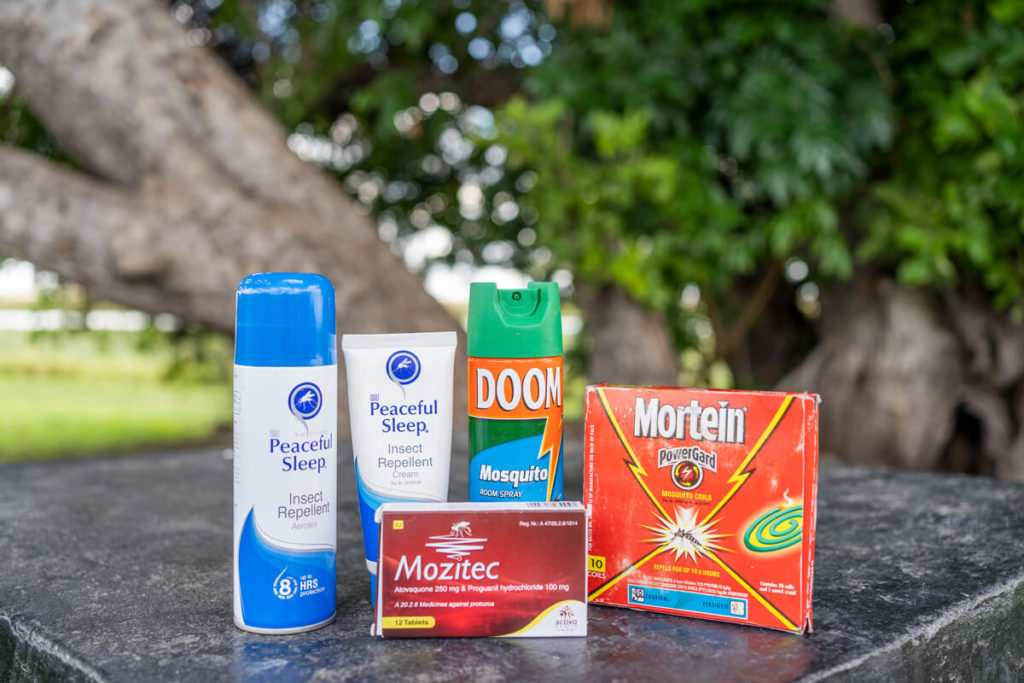
Should I take malaria tablets?
As already mentioned, we also treated our clothing with Nobite*, which greatly minimized the risk of bites. When choosing colors, you should especially opt for light colors, as dark fabrics are much more attractive to mosquitoes. You should also wear long trousers and long shirts, as well as socks and sturdy shoes, in the evening. This will help you avoid annoying mosquito bites.
Since we were in the humid Okavango Delta during the “malaria peak season,” we also took malaria tablets. We bought them at a pharmacy in Botswana (name: Mositec – similar to Malarone) and tolerated them very well. We didn’t notice any side effects.
It’s best to discuss your plans with a doctor you trust and get advice on malaria on site. You can also make an appointment at a tropical institute and speak with a specialist. Ultimately, it’s up to you to decide whether you want to take tablets for prevention or not.
We can only speak from our own experience and say that we felt safer with the malaria tablets in a high-risk area. Of course, they don’t protect against bites or the disease itself, but they can mitigate the course of the illness.
Safari Packing List – Can I do laundry while traveling?
It always depends a bit on where you are traveling. In South Africa, for example, you can have your laundry done almost anywhere (laundry or accommodation), wash it yourself in a washing machine, or simply by hand. This certainly applies to many other countries as well. On our tour through Botswana, we washed our own laundry in a bowl with water and detergent.
We bought a clothesline with a few pegs (also available online*) and hand soap from a supermarket beforehand. We could always stretch the line between two trees and hang our wet laundry there. Given the very warm temperatures, the laundry dried in just 1 to 2 hours. Such “gadgets” have also proven their worth in South Africa, Morocco, Mauritius, and Namibia.
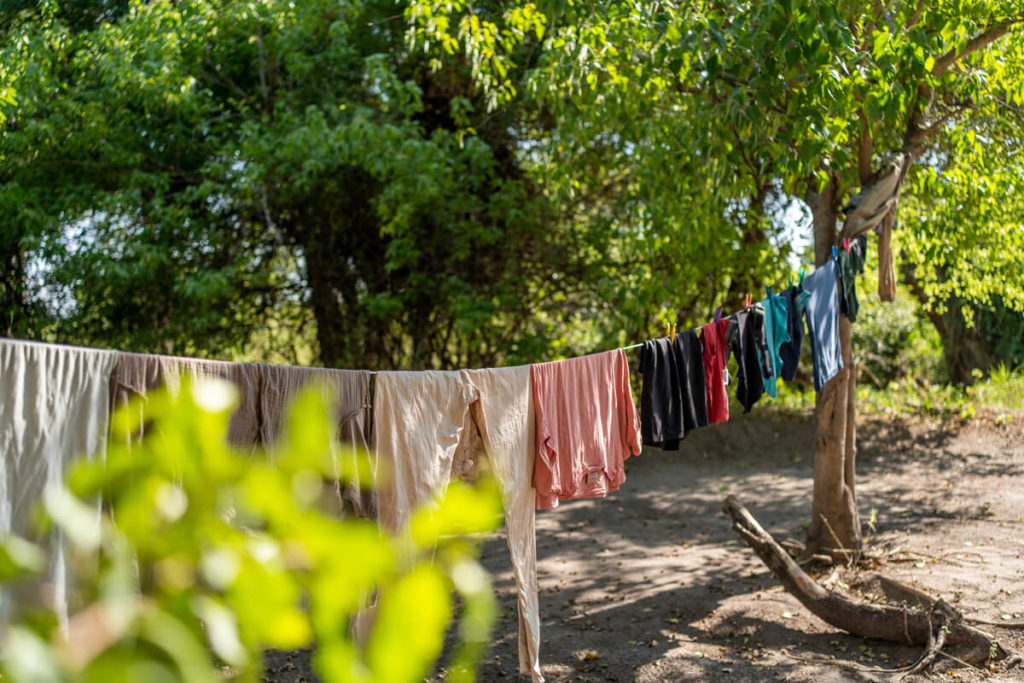
Which binoculars do you recommend for a safari?
A pair of very good binoculars should definitely be on your safari packing list! We are extremely satisfied with our ProStaff 7 binoculars from NIKON*. The 8x magnification and the fast lenses deliver an incredibly sharp and detailed image. At 650 grams, the binoculars are also very light and fit in any safari pack. Thanks to their non-slip texture, the binoculars sit comfortably in the hand and are quick and easy to adjust.
It’s also great that the binoculars come with a small bag, eyepiece, strap, and lens cap. We later attached one of our cool camera straps* to the binoculars so we could also wear them around our necks. During our last safari trips, we used the binoculars every day and they never disappointed us. It’s a shame we didn’t discover these binoculars sooner. Click here for our detailed review.

Which lens do you use on safari?
Your safari packing list should definitely not be without a telephoto zoom lens, unless good photos of wild animals aren’t that important to you. We love wildlife photography and therefore attach great importance to having good equipment with you on safari. In most cases, the animals are far away, so you need a lens that allows you to get close. A focal length of up to 400 mm or even 600 mm is recommended. This allows you to get very close to the animals, even if you are a few hundred meters away.
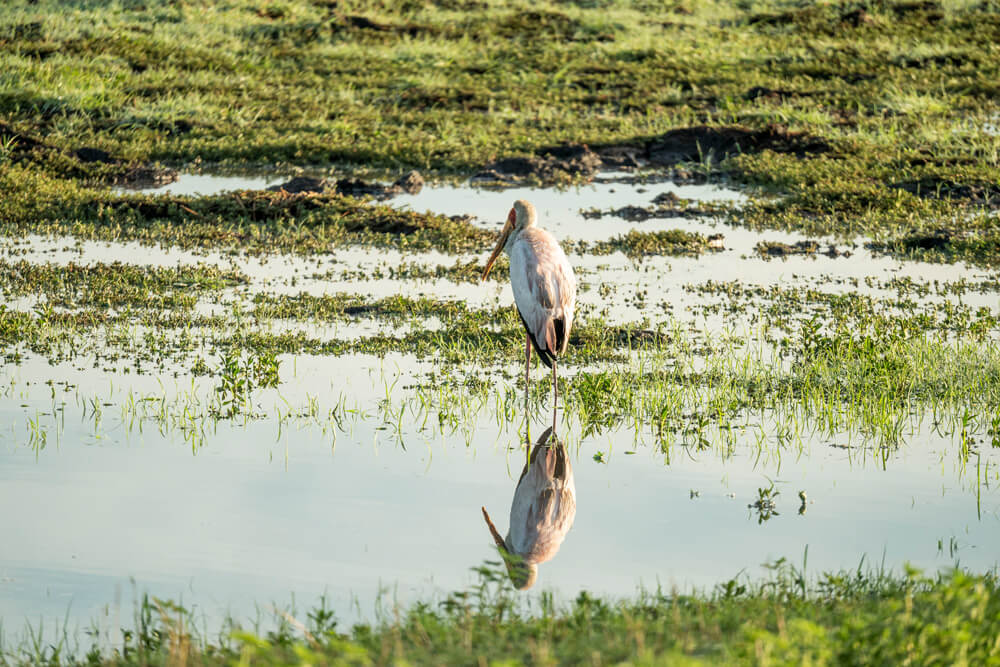
We have the Tamron 105-500mm* (full-frame for Sony) and are very satisfied with this lens. The optical performance, stabilization, autofocus, and general quality of the lens are very good. The lens does weigh a good 1.7 kg, but that’s something you have to accept for a powerful telephoto zoom in this category. The lens has also proven itself for filming on numerous occasions, although you should also use a tripod.
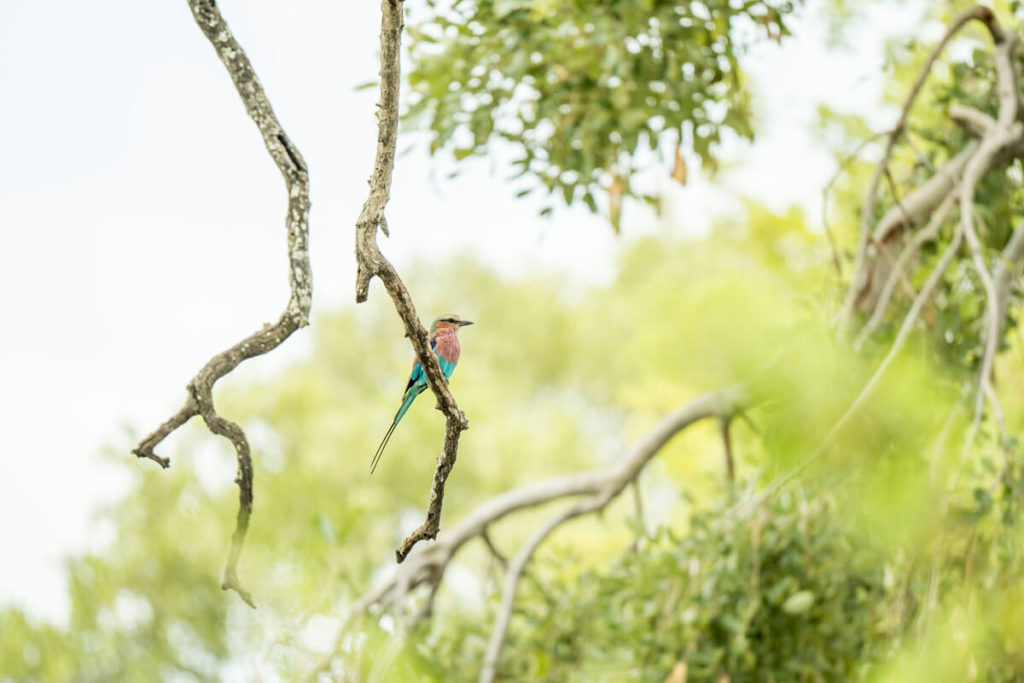
On our first trips to Africa, we always took the Sony 200 mm – 600 mm lens* with us. This also offers very good performance, but is almost €400 more expensive. We used to rent this lens from mietdeinobjektiv.de*. This is a very good alternative to buying, since you often only need a lens like this once or very rarely. You can also rent cameras and accessories on the site. We were always thrilled with this service.
What other technical equipment do you have with you?
We always bring a lot of technology with us on our travels. This is also because we earn our money with photos, videos, and travel reports. In the following table, we have listed the most important gadgets in our equipment, which we use on most of our trips. It is important that your charging stations, for example, for camera batteries, can be charged via USB. This way, you can charge most things (including smartphones) while driving in the car or, in a pinch, with a power bank.
Insurance tip: Since we always travel with very expensive technical equipment, we always insure our cameras, accessories, and laptops for one year with Allianz*. Last time, we paid only about €78 for the one-year camera insurance (including lenses and accessories). Coverage includes damage caused by theft and robbery, damage caused by liquid and moisture penetration, and also damage caused by natural disasters, falls, and accidents. You can purchase this insurance here*.
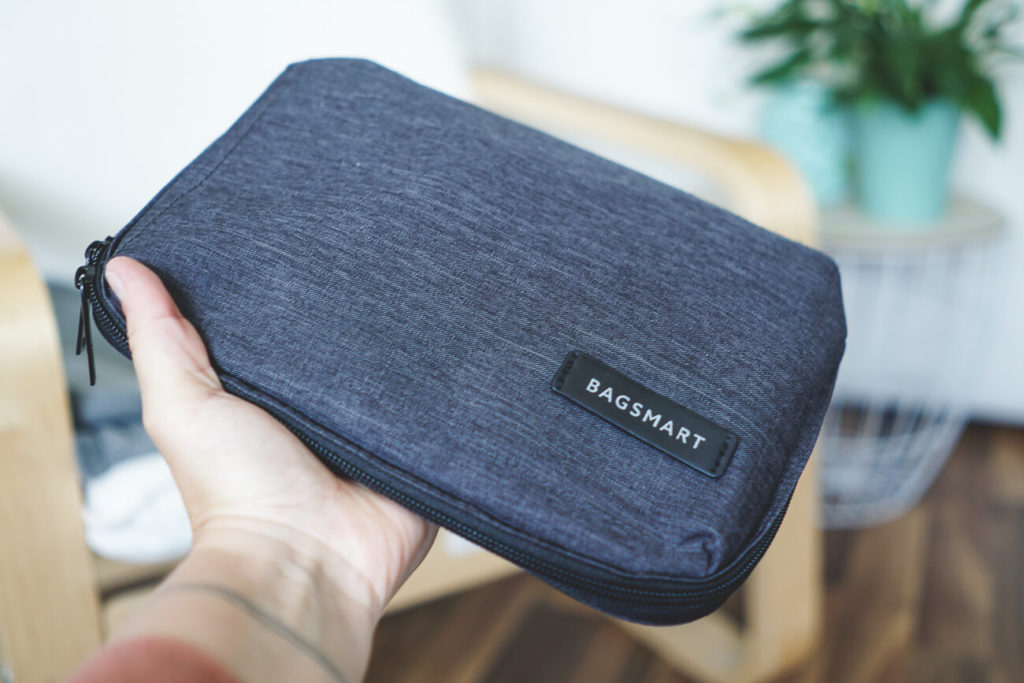
What else shouldn’t be missing from your luggage?
On our last trip, we also brought duct tape* with us, which we actually used frequently. We used it to seal up food, or to fix one thing or another. We also always carry a dry bag* with us in case we do go on the water. We always pack our camera and cell phone in there to protect them from moisture and wetness.
To keep our technology and valuables safe, we also use a Pacsafe (12 L)* when traveling. The Pacsafe is a type of portable safe with an integrated steel mesh that protects your bag from being slashed. Books and smaller games (e.g., Qwixx*, Fantastic Realms*, or CATAN*) are also essential for in-between activities.
E-books are, of course, best, but we love having printed books with us. We also take a notebook* with us on every trip, as well as a jute bag, which we always use for shopping. We always take wine and beer openers, as well as pocket knives* with us, especially on camping trips.
Also, get the Tracker Manual* – a real must-have for anyone traveling in Africa who wants to learn more about animal tracks. The book shows you the tracks of over 190 animal species, with clear illustrations, numerous photos, and practical tips. It’s the perfect companion for your safari or hike!
Conclusion on the packing list
With our safari packing list, you should now be perfectly prepared for your own African adventure. Of course, you don’t need EVERY item we’ve listed here. This list is intended only as a reminder and inspiration. We sincerely hope you enjoyed our packing list and that you can use some of the tips for yourself.
Our next safari trip is scheduled for summer 2025, and we’re already looking forward to starting travel planning again. And to make sure we don’t forget anything, we’ll also take a quick look at our packing list.